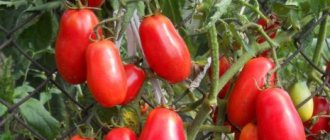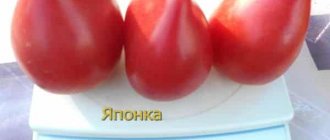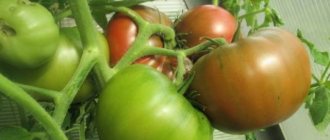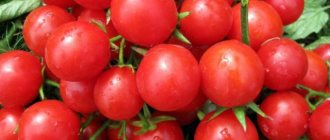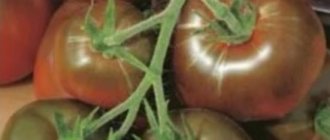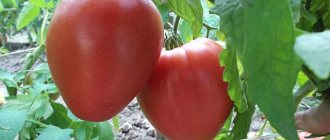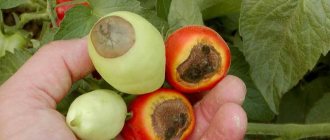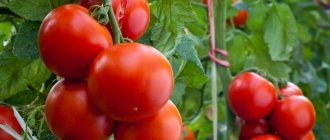Description of tomatoes Andreevsky surprise
Describing the late-ripening variety Andreevsky Surprise, it should be noted that it was created by Siberian breeders. This means that it can be grown in risky farming areas. In 2007, it was included in the State Register of the Russian Federation and recommended for cultivation in greenhouses and in open ground on personal plots. In the southern regions of Russia, tomatoes bear fruit well in open beds; in other regions it is more advisable to grow St. Andrew's surprise in greenhouses.
The variety is indeterminate, which means it is unlimited in growth. The stems of the Andreevsky Surprise tomato can grow up to 2 m. The leaves of this variety of tomatoes are medium in size and have a dark green color. Every 3 leaves the plant forms an inflorescence, which belongs to the intermediate type. The flowers are bisexual, self-pollinating, but cross-pollination by wind and insects is also possible. The first brush appears after the formation of 8-9 leaves. Tomatoes ripen gradually, starting from the lower clusters. The peduncle has an articulation. The variety requires partial removal of the stepsons and garter.
Description of fruits
The taste of tomatoes is determined by the content of sugars and acids. The more sunny days, the higher this ratio, the better the taste of tomatoes. The fruits are characterized by excellent taste, in addition to which there are several other qualities:
- The fruit is flat-round, smooth, of medium density.
- The color of the pulp and skin of ripe tomatoes is rich, pink.
- The pulp is dense and juicy, multi-chambered.
- Fruit weight is 150-300 g, can reach 600 g.
- High taste qualities.
- Versatility of use: fresh, pickled, salted.
Advantages and disadvantages of the variety
Pros:
- allows both greenhouse cultivation and open ground;
- large fruits with excellent taste;
- undemanding to lighting (seedlings tolerate low light well)
- resistant to late blight
Minuses:
- fruits are prone to slight cracking when harvesting a ripe crop is delayed and due to excessive watering;
- slightly lower yield compared to analog varieties, which is compensated by the excellent quality of the fruits
Characteristics of tomato Andreevsky surprise
The Andreevsky Surprise variety has proven itself well when grown throughout Russia, including the northern regions.
Productivity and fruiting
The yield of the variety ranges from 3.5 to 8 kg per square meter. m and depends on growing conditions. When growing tomatoes in greenhouses with all the necessary agrotechnical practices, the yield reaches a maximum. When grown in unprotected soil, yields drop due to unstable climatic conditions.
For an indeterminate, the yield of the Andreevsky Surprise tomato, judging by the reviews, is small, but the quality of the tomatoes shown in the photo makes up for this drawback.
The fruiting period begins in the second half of July, the ripening of tomatoes is uniform, not extended. The last harvest of tomatoes should be done at the end of August. Unripe fruits are stored in a warm and dark place; they will soon turn red.
Area of application of fruits
Tomatoes of the Andreevsky Surprise variety, according to reviews, are intended for fresh consumption in salads and for preparing vegetable dishes. The rich, rich taste and dense pink flesh of tomatoes make dishes tasty, juicy and bright. These same qualities make it possible to obtain from tomatoes no less tasty and healthy juices, pastes and ketchups with a rich tomato taste and pleasant consistency.
Resistance to diseases and pests
Tomato Andreevsky Surprise, with proper care, is not susceptible to one of the most common nightshade diseases - late blight. He has good immunity and is resistant to diseases. This important factor adds adherents to this variety.
Advantages and disadvantages of the variety
The Andreevsky Surprise tomato has many advantages:
- taste;
- large fruit;
- disease resistance;
- universal application;
- unpretentiousness.
Flaws:
- average yield;
- tendency of fruits to crack.
Video
??REVIEW OF TOMATOES on 07/29 in the greenhouse. ANDREEVSKY SURPRISE, MOTHER-IN-LAW'S TONGUE, BULL'S FOREOW, VERNA, OLGA
THE LARGEST TOMATOES FOR OPEN GROUND! Olga Chernova.
BEST YIELDING TOMATO VARIETIES 2022 GREENHOUSE REVIEW (07/31/2017)
My notes_tomato Andreevsky surprise
50 exotic varieties of tomatoes in one bed
The best varieties of meaty tomatoes. 5 varieties of large-fruited tomatoes. Tomatoes 2022 Siberian selection.
A tomato that grows like a weed, without care, with a huge harvest.
Common tomato Olesya. Brief overview, description of characteristics, where to buy seeds
Low-growing (determinant) varieties of tomatoes! Do I need to tie them up?? My opinion…
Planting tomatoes for seedlings
THE LARGEST TOMATO HAS RIPEN IS YOUR FAVORITE HOLIDAY. Olga Chernova.
FIVE BEST LARGE FRUITED TOMATO VARIETIES. According to reviews from gardeners
Growing rules
When growing tomatoes, including the Andreevsky Surprise variety, you should follow some rules:
- Grow in a sunny place.
- Provide sufficient moisture.
- The vegetable must ripen on the bush.
- Proper feeding is required.
And also do not neglect loosening, weeding, and mulching.
Planting seedlings
The conditions for growing tomatoes in seedlings are traditional. But the Andreevsky Surprise variety has a distinctive feature - the seedlings do not require additional lighting.
It is enough to pour a 6-8 cm layer of soil into the seedling boxes. Distribute the tomato seeds according to the pattern: 2 cm between tomatoes in a row and 4 cm between rows of tomatoes.
Seedlings will develop well at a temperature of + 25-28 ° C.
At temperatures below + 18 °C, the growth of seedlings stops. This fact can be used if the seedlings are overgrown. To maintain a high temperature, seedling containers are covered with film.
The crops are ventilated daily by lifting the film. Water with a spray bottle, avoiding over-watering. The first tomato seedlings will sprout in 4-6 days.
A few tips will help you avoid errors when growing:
- Picking seedlings when 2 true leaves appear. The sooner the plants are transplanted, the faster they adapt to new conditions and strengthen the root system. This procedure should be performed up to 3 times during the growing of seedlings. Since the variety is indeterminate, picking is aimed at restraining plant growth without shifting the start of fruiting.
- Deepening tomato seedlings St. Andrew's Surprise to the cotyledon leaves to form additional roots.
- Carrying out the first fertilizing of tomato bushes a week after picking. Fertilizers are used no more than 2 times during the entire period.
- Don't forget about hardening off the seedlings. A month before planting in the ground, the seedlings are taken out into the fresh air, gradually increasing the time spent outside.
The seedlings are transferred to the greenhouse in early May. The transplantation of seedlings into open ground will occur later, after the average daily temperature has reached at least + 15 °C. The date for planting tomatoes depends on the specific region.
Tomato transplant
Seedlings that are going to be transplanted into open ground or a greenhouse have certain requirements. Tomato seedlings St. Andrew's Surprise, judging by the reviews of gardeners, should have a thick stem, large dark green leaves and a powerful root system.
At the time of transplantation, the seedlings should have one flower cluster, but with unopened buds. If the flowers have already bloomed, vegetable growers recommend removing them. But there is no point in removing the first flower of this variety - this does not increase the yield, and the largest fruit will be lost.
The optimal age of seedlings for planting is 60-65 days. Tomatoes are planted at the rate of 2 plants per 1 sq. m or according to the 50x50 cm pattern.
A description of transplanting the tomato variety Andreevsky Surprise will be incomplete without highlighting several important points:
- Tomato stems are tied immediately upon planting to supports in the form of stakes or trellises.
- Self-grown seedlings can be planted in a permanent place at any time of the day, while purchased seedlings can be planted in cloudy weather or in the evening.
- It is advisable to bury the stems of tomatoes not reaching the first true leaves of 2-3 cm. Overgrown seedlings are placed in furrows, leaving a seedling of normal height above the soil surface.
Subsequent care for tomatoes
To ensure that the work on growing seedlings is not wasted, it is necessary to create favorable conditions for the formation of high-quality fruits, namely:
- systematic watering;
- fertilizing;
- removal of stepsons;
- tying to supports as you grow;
- formation of tomato bushes into 1-2 stems.
Water the tomatoes with settled water 2 times a week, in the morning or evening. The bushes are watered abundantly.
During the season, fertilizing is required three times. The first fertilizing is aimed at enriching the soil with organic and nitrogen fertilizers. During the period of the appearance of ovaries, potassium fertilizers are necessary. When fruits are forming, tomatoes are fed with complex phosphorus-potassium compounds.
Removing side shoots (side shoots) that appear in the leaf axils increases the supply of nutrients to tomatoes. The pinching technique is used to accelerate the ripening of fruits. Tomato shoots must be removed until they exceed 5 cm by pinching or breaking off by hand.
The greenhouse is regularly ventilated and the temperature is maintained no higher than + 30 °C.
In order for the set fruits to have time to ripen, the tops of the shoots must be pinched in early August in the northern regions and at the end of August in the south.
Features of planting in the ground
In a permanent place - in a greenhouse or just in a garden bed - these tomatoes are usually placed according to a 50x40 cm pattern. At the same time, they ensure that there are 3-4 bushes per 1 m2. The roots of St. Andrew's surprise seedlings usually reach a considerable length. Experienced summer residents therefore advise preparing holes 30-40 cm deep for them in advance - in the fall.
At the bottom of such holes, a little earth mixed with organic matter is usually poured. Then the tomato is placed in the hole and rolled over with fertilized soil and a tamper.
Pest and disease control
Even in disease-resistant varieties, the disease can develop due to unfavorable weather conditions or errors in care. Therefore, sufficient attention should be paid to the prevention of tomato diseases.
Mosaic is a viral disease that occurs both in the greenhouse and in open beds. As a result of the disease, the shape and color of the leaves changes. Yellow and green spots alternate on them. Tomatoes reduce their yield, gradually turn yellow and die as a result. Diseased plants should be removed and burned.
For preventive purposes:
- It is better to take seeds that are 2-3 years old for sowing;
- Before planting, seeds are soaked for 25-30 minutes in a 1% solution of potassium permanganate;
- seedlings are treated with skim milk every 10 days (1 liter of milk and 1 teaspoon of urea are dissolved in 10 liters of water).
Late blight is a fungal disease that appears on all parts of tomatoes as brown spots and a white coating on the underside of the leaf. The fruits are also covered with subcutaneous brown spots.
For the treatment and prevention of late blight, it is effective to spray the crop with a solution of calcium nitrate (1 tablespoon per 10 liters of water), an iodine solution (1 teaspoon per 10 liters of water), as well as the drug Profit Gold.
Watering, fertilizing
Regular irrigation will provide the moisture required for fruit development. The procedure must be carried out once every 7 days in warm weather and three times a week if it is hot outside. Watering is recommended after sunset. The soil mixture should be moistened, but not wet.
During the growing season, fertilizers are applied in several stages:
- 21 days after planting, 1 liter of solution prepared from 10 liters of liquid, 25 g of urea, 15 g of potassium and 40 g of phosphorus fertilizers is sent to each bush;
- during the formation of ovaries, a solution of mullein is needed: 25 g of potassium sulfate and 500 ml of organic matter are diluted in 10 liters of liquid;
- for good ripening of fruits, dissolve 2 tbsp in a bucket of liquid. l. superphosphate and 1 tbsp. l. sodium humate.
